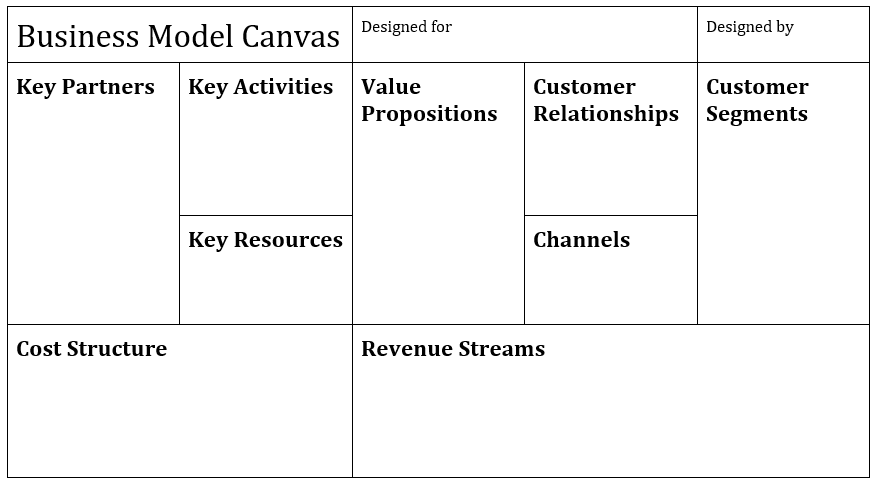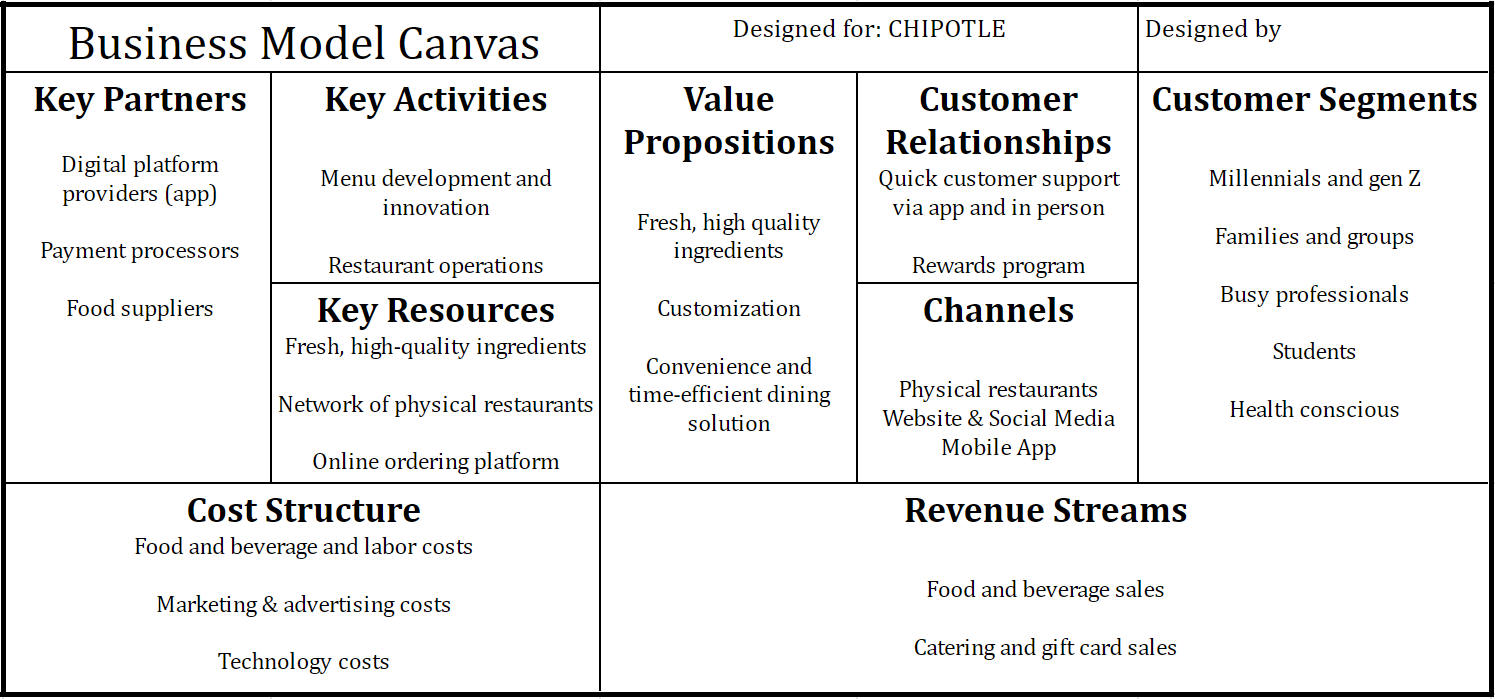Chapter 9: Business Models
Business Models
In this chapter, the concept of the business model is introduced. One concept of the business model in particular, the Business Model Canvas, is explored as a way to conceptualize and categorize elements of a business model.
The Business Model Canvas
The Business Model Canvas is a strategic management tool that provides a visual framework for developing, describing, and analyzing a business model. It consists of nine key components (or blocks), which are organized on a single page. This tool helps entrepreneurs quickly map out their business strategy and identify areas for improvement. See the example in Figure 9.1.
The Business Model Canvas was created by Alexander Osterwalder. He developed the model in collaboration with Yves Pigneur, and it was first introduced in their 2010 book Business Model Generation (Mind Tools Content Team, n.d.).

Why The Business Model Canvas Method?
The Business Model Canvas (BMC) offers a focused and dense overview by consolidating key elements onto a single page, preventing business owners from becoming overwhelmed by excessive details. Its compact format is easier to review than lengthy reports, and its customizable nature allows for multiple templates to be created, compared, and refined to identify the best fit (Pereira, 2021).
BMC Components
The BMC is made up of specific components, sometimes referred to as blocks. Generally, they are developed in a specific order. See the blocks for a BMC in Table 9.1.
| Component or Block | Purpose |
|---|---|
| Customer Segments | Identifies and describes the different groups of people or organizations that a business aims to reach and serve. It helps in understanding who the customers are, what their needs are, and how to tailor offerings to them. |
| Value Propositions | Defines the bundle of products and services that create value for a specific customer segment. This block clarifies what makes the business’s offer attractive and how it solves a problem or fulfills a need. |
| Channels | Describes the various ways a business delivers its value proposition to customers. This includes distribution, sales, and communication channels and helps in understanding how to effectively reach and interact with customers. |
| Customer Relationships | Outlines the types of relationships a business establishes with its customer segments. It includes customer acquisition, retention strategies, and how to build and maintain long-term relationships. |
| Revenue Streams | Details the ways a business generates income from each customer segment. It includes pricing mechanisms, revenue models, and the types of revenue (e.g., one-time sales, subscription fees). |
| Key Resources | Lists the assets required to deliver the value proposition, reach markets, and sustain operations. This includes physical, intellectual, human, and financial resources crucial for the business’s functioning. |
| Key Activities | Describes the main actions and processes needed to deliver the value proposition, reach customers, and maintain customer relationships. This includes production, problem-solving, and platform/network activities. |
| Key Partners | Identifies external organizations or entities that help the business achieve its objectives. This includes alliances, joint ventures, and suppliers that contribute to key activities and resources. |
| Cost Structure | Outlines the major costs associated with operating the business model. It includes fixed and variable costs, economies of scale, and cost drivers, helping in understanding the financial implications of the business operations. |
Business Model Canvas Blocks
Expand each BMC component for considerations for each.
To build a successful business model, start by filling out the nine components of the Business Model Canvas with initial plans and assumptions. Then, as the business is starting and more is learned through interactions with potential customers, these components can be updated with new, more accurate information. The business owner should personally engage with customers and business operations to fully understand the needs and refine the business model until it works.
The creation of the Business Model Canvas should precede a brief or full business plan document. Understanding the business model helps create a sound business plan.
Pause and Reflect
- Reflect on the practical benefits of using the Business Model Canvas compared to traditional business plans. How does its single-page format help in managing and understanding a business model?
BMC Example
Chipotle Mexican Grill has established itself as a leader in the fast-casual dining industry by focusing on fresh ingredients, customizable menu options, and convenience. To better understand the business model that drives Chipotle’s success, we can analyze it through the Business Model Canvas framework. This tool breaks down the company’s operations into nine key components, providing a comprehensive view of how Chipotle creates, delivers, and captures value (Pahwa, 2023).
This BMC example for Chipotle shown in Figure 9.2 below, is a highly visual model that fits on a single page. It consists of concise points, allowing you to quickly grasp the business by spending just a few minutes reviewing the visual information.

- Key Partners play a crucial role in supporting Chipotle’s operations. The company collaborates with digital platform providers to power its mobile app, which is essential for online ordering and customer engagement. Payment processors facilitate smooth and secure transactions, both in-store and online. Additionally, Chipotle relies on a network of food suppliers to maintain its commitment to fresh, high-quality ingredients.
- Key Activities at Chipotle revolve around continuous menu development and innovation to meet ever-changing customer preferences. The company also focuses heavily on efficient restaurant operations to ensure a consistent and high-quality customer experience.
- The Value Propositions that Chipotle offers are central to its brand identity. The emphasis on fresh, high-quality ingredients appeals to health-conscious consumers, while the ability to customize meals allows customers to tailor their dining experience. Moreover, Chipotle positions itself as a convenient and time-efficient dining solution, attracting busy individuals who seek a quick yet satisfying meal.
- Chipotle maintains strong Customer Relationships by providing quick customer support through both its app and in-person interactions. The company also encourages loyalty through its rewards program, earning repeat business and deepening customer engagement.
- In terms of Customer Segments, Chipotle targets a diverse demographic. Millennials and Gen Z are drawn to its brand because of its focus on sustainability and convenience. Families and groups appreciate the flexibility in menu options, while busy professionals and students find the convenience and speed of service particularly appealing. The brand also resonates with the health-conscious segment, thanks to its emphasis on fresh and nutritious ingredients.
- To support its business model, Chipotle relies on several Key Resources, including its fresh, high-quality ingredients, a robust network of physical restaurants, and an online ordering platform that enhances accessibility and customer convenience.
- The company reaches its customers through multiple Channels, including physical restaurants, a user-friendly website, social media, and a mobile app. These channels ensure that Chipotle is accessible to a wide audience and can effectively communicate its brand message.
- The Cost Structure of Chipotle reflects its commitment to quality and innovation. Food and beverage costs and labor costs are significant, given the company’s focus on fresh ingredients and customer service. Additionally, marketing and advertising costs play a vital role in maintaining brand visibility and attracting new customers. Technology costs are also a consideration, particularly with the ongoing development and maintenance of its digital platforms.
- Chipotle generates its Revenue Streams primarily through food and beverage sales in its restaurants. Catering and gift card sales provide additional income, contributing to the company’s overall profitability.
Through this detailed breakdown, the Business Model Canvas illustrates how Chipotle effectively combines various elements of its business to create a compelling value proposition that resonates with a broad customer base.
If you were to replace “Chipotle” with “McDonald’s” or any other restaurant, the Business Model Canvas (BMC) would no longer be accurate. Chipotle’s BMC is uniquely tailored to its operations and brand identity. While some elements of Chipotle’s business model may overlap with those of other companies, the complete picture presented by this BMC is distinctively Chipotle’s. It reflects the specific strategies, values, and operational practices that set the company apart in the fast-casual dining industry.
Additional Resources
There are many resources that help further explain the Business Model Canvas, provide templates, and share examples. Here are a few of our favorite resources:
Key Takeaways
- The Business Model Canvas is a strategic management tool that helps entrepreneurs develop, describe, and analyze their business model through a visual framework consisting of nine key components organized on a single page.
- Created by Alexander Osterwalder and Yves Pigneur, the Business Model Canvas was first introduced in their 2010 book Business Model Generation.
- The nine components of the Business Model Canvas include Customer Segments, Value Propositions, Channels, Customer Relationships, Revenue Streams, Key Resources, Key Activities, Key Partners, and Cost Structure, each serving a specific purpose in detailing different aspects of the business.
- Creating a Business Model Canvas is a precursor to drafting a business plan, as it helps in understanding and developing a solid foundation for the business plan.
- The Business Model Canvas is uniquely tailored to reflect the specific operations, strategies, and brand identity of a company. While some elements may overlap with those of other businesses, the complete picture presented by the BMC is distinct to the organization it represents.
A strategic management tool that provides a visual framework for developing, describing, and analyzing a business model. It consists of nine key components (or blocks), including value propositions, customer segments, and revenue streams, which are organized on a single page. This tool helps entrepreneurs quickly map out their business strategy and identify areas for improvement.

